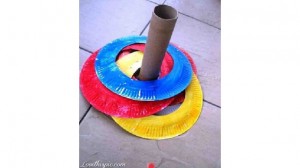This unit explores the use of self – made material as a resource to enhance the possibilities of the Cooperative Learning model. The process of constructing and sharing equipment fosters the five critical elements of Cooperative Learning in physical education. When students are asked to build a piece of equipment with their mates or parents, they are guided into a face – to – face interaction process. Consequently, interpersonal skills are developed through group processing in order to solve contingencies. The challenge of the task implies individual accountability, because students must create low – cost, efficient equipment for the group. Once built, these self – made material can be integrated in physical education sessions like conventional equipment, with all the advantages that the process of construction has generated (creativity, active learning, students centred – learning, social learning).
In today´s sustainability – oriented curriculum the mantra is reduce, reuse and recycle in every aspect of our life. Over the past forty years, different authors have worked on the idea of employing ´use or old´ materials to create equipment for physical education or recreation. All them were talking about ´found´, ´throw away´, ´non – traditional´ or ´recycled´ material that are not difficult to adapt and use in physical education.
With this in mind, the first pillar of this ´homemade´ approach to physical education equipment is the idea of raising ecological awareness in the school community. Thus, the goal would be to increase the student´s consciousness of the physical environment, so they could become sustainability – oriented.
The second pillar of this approach is the scarcity and over cost of materials in physical education as a result of limited budgets. It is considered that activities are often inequitably chosen due t the absence of material resources, which in turn, affects students and their movement experiences. Therefore, the quantity and quality of a school´s equipment can detrimentally influence the excellence of its physical education curriculum. Moreover, in many cases, large classes and the lack of enough equipment prevent children from having time to practice and improve their psychomotor skills.
With this Unit, Students will:
• construct their own materials.
• get physical exercise as they learn about local recycling efforts.
• learn about the importance of recycling.
• raise ecological awareness as social values.
• understand that money doesn´t mean everything.
In order to develop this unit, students must build these materials. To make easier the comprehension, materials are described in spanish language.
Suaviball: Bote de suavizante, lejía o detergente que tenga asa. Se recorta la parte de abajo del envase para que quede un hueco en esa parte. Hay que pulir la zona cortada y decorarlo.
Pelotas: Introducir arroz en una bolsa. Meter esa bolsa en un globo y luego en otro globo. Poner cinta aislante alrededor de los globos para evitar posibles roturas.
Yogurball: En un envase de yogur, se hace un pequeño agujero en la parte de debajo. A continuación se pasa un cordón o hilo y se hacen varios nudos. En el otro extremo del cordón se coloca una bola o tapón de botella.
Bolos: Con botellas de plástico decoradas. Introducir la misma cantidad de arena en todas.
Juego de los aros: Sobre una base se pega un cartón de papel de cocina. Posteriormente, se decora. Los aros pequeños se pueden realizar recortando cartones o platos de cocina de plástico.
Mazas: Se introduce un palo de madera o plástico en un envase. Reforzar y decorar.




